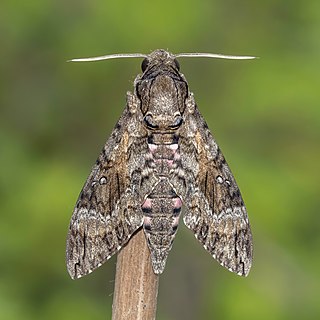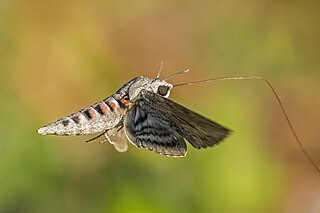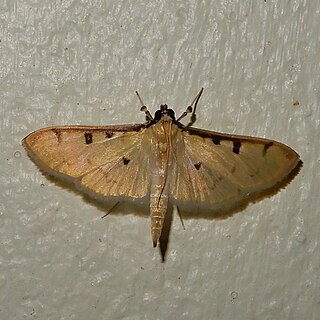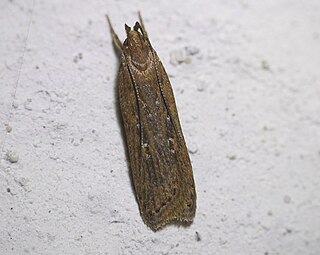
Pterophorus pentadactyla, commonly known as the white plume moth, is a moth in the family Pterophoridae. It is found in the West Palearctic including North Africa and Europe. The wingspan is 26–34 mm (1.0–1.3 in). It is uniformly white, with the hind wing pair divided in three feathery plumes and the front pair in another two. The moths fly from June to August. The larvae feed on bindweed.

Agrius cingulata, the pink-spotted hawkmoth or sweetpotato hornworm, is a moth in the family Sphingidae. The species was first described by Johan Christian Fabricius in 1775.

Agrius convolvuli, the convolvulus hawk-moth, is a large hawk-moth. It is common throughout Europe, Asia, Africa, Australia and New Zealand, partly as a migrant. In New Zealand, it is also known as the kumara moth, and in the Māori language as hīhue.

Helcystogramma is a genus of moths in the family Gelechiidae. The genus was erected by Philipp Christoph Zeller in 1877.
Udea despecta, the Hawaiian sweetpotato leafroller, is a moth of the family Crambidae. It is endemic to the Hawaiian islands of Kauai, Oahu, Molokai, Maui, Lanai and Hawaii.

Dichomeridinae is a subfamily of moths in the family Gelechiidae.
Helcystogramma flavescens is a moth of the family Gelechiidae. It is found in Russia. The habitat consists of grassy steppes.

Helcystogramma hystricella, the lanceolate helcystogramma moth, is a moth in the family Gelechiidae. It is found in the United States, where it has been recorded from Minnesota to Pennsylvania, south to Maryland and Kentucky, west to Oklahoma and Kansas.

Lygropia tripunctata, commonly known as the sweetpotato leafroller, is a species of moth in the family Crambidae. It was first described by Johan Christian Fabricius in 1794. It is found in the United States, where it has been recorded from Texas to South Carolina and Florida. It is also found from the West Indies and Central America to Brazil.

Helcystogramma triannulella is a species of moth in the family Gelechiidae. It was originally described by Gottlieb August Wilhelm Herrich-Schäffer in 1854. It is found in south-western and south-eastern Siberia, the Caucasus, Transcaucasia, Kazakhstan, Korea, Japan, China, northern India and large parts of Europe, except Ireland, Great Britain, the Netherlands, Denmark, Scandinavia, the Baltic region and the western Balkan Peninsula.
Helcystogramma flavifuscum is a moth in the family Gelechiidae. It was described by Hou-Hun Li and Hui Zhen in 2011. It is found in Guangxi, China.
Helcystogramma brevinodium is a moth in the family Gelechiidae. It was described by Hou-Hun Li and Hui Zhen in 2011. It is found in the Chinese provinces of Hebei and Tianjin.
Helcystogramma furvimaculare is a moth in the family Gelechiidae. It was described by Hou-Hun Li and Hui Zhen in 2011. It is found in Guizhou, China.
Helcystogramma imagitrijunctum is a moth in the family Gelechiidae. It was described by Hou-Hun Li and Hui Zhen in 2011. It is found in Taiwan and the Chinese provinces of Guizhou, Jiangxi and Zhejiang.
Helcystogramma rectangulum is a moth in the family Gelechiidae. It was described by Hou-Hun Li and Hui Zhen in 2011. It is found in the Chinese provinces of Guizhou, Hunan, Shaanxi and Sichuan.
Helcystogramma badia is a moth in the family Gelechiidae. It was described by Annette Frances Braun in 1921. It is found in North America, where it has been recorded from California and Nevada to southern British Columbia and Utah.
Helcystogramma casca is a moth in the family Gelechiidae. It was described by Annette Frances Braun in 1925. It is found in North America, where it has been recorded from southern Saskatchewan and British Columbia to Utah, Colorado and Oregon.
Helcystogramma chambersella is a moth in the family Gelechiidae. It was described by Mary Murtfeldt in 1874. It is found in North America, where it has been recorded from Pennsylvania, Illinois, Ohio, South Carolina, Tennessee, Louisiana, Mississippi, Florida, Oklahoma, Missouri, Texas, Arizona and California.

Helcystogramma melanocarpa is a moth in the family Gelechiidae. It was described by Edward Meyrick in 1929. It is found in North America, where it has been recorded from Nova Scotia to New Brunswick to South Carolina and to Texas.
Helcystogramma melantherella is a moth in the family Gelechiidae. It was described by August Busck in 1900. It is found in North America, where it has been recorded from North Carolina south to Florida and west to Texas and Arkansas.








